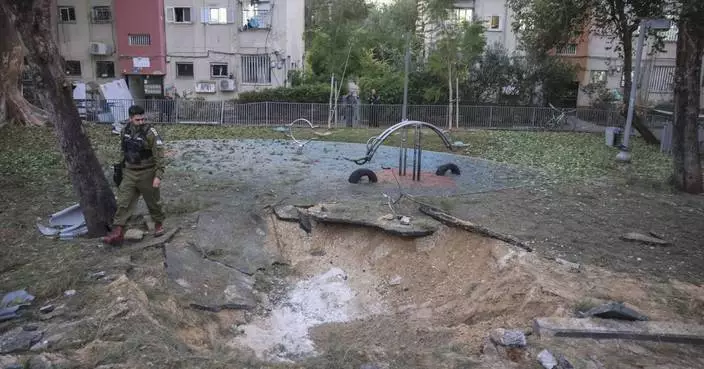NEW YORK (AP) — Journalists at a news site that covers the Haitian community in the United States say they've been harassed and intimidated with racist messages for covering a fake story about immigrants eating the pets of people in an Ohio town.
One editor at the Haitian Times, a 25-year-old online publication, was “swatted” this week with police turning up at her home to investigate a false report of a gruesome crime. The news site canceled a community forum it had planned for Springfield, Ohio and has shut down public comments on its stories about the issue because of threats and vile posts.
The Times, which had the Committee to Protect Journalists conduct safety training for its journalists in Haiti, has now asked for advice on how to protect staff in the United States, said Garry Pierre-Pierre, founder and publisher.
“We've never faced anything like this,” Pierre-Pierre said Wednesday.
The Times has debunked and aggressively covered the aftermath of the story about immigrants supposedly eating the dogs and cats of other Springfield residents, as it was spread by Ohio Sen. JD Vance, Donald Trump's Republican running mate in the presidential election, and Trump himself in his debate with Democrat Kamala Harris.
Despite receiving hundreds of these messages, the site isn't backing down, said Pierre-Pierre, a former reporter at The New York Times who echoed a mission statement from his old employer in making that promise.
“We do not want to hibernate,” he said. “We're taking the precautions that are necessary. But our first duty is to tell the truth without fear or favor, and we have no fear.”
Pierre-Pierre, who emigrated to the United States in 1975, started the Haitian Times to cover issues involving first- and second-generation Haitians in the United States, along with reporting on what is happening in their ancestral home. It started as a print publication that went online only in 2012 and now averages 10,000 to 15,000 visitors a day, although its readership has expanded in recent weeks.
Macollvie Neel, the New York-based special projects editor, was the staff member who had police officers show up at her doorstep on Monday.
It was triggered when a Haitian advocacy group received an email about a crime at Neel's address. They, in turn, notified police who showed up to investigate. Not only did the instigators know where Neel lived, they covered their tracks by funneling the report through another organization, she said.
Neel said she had a premonition something like this might happen, based on hateful messages she received. But it's still intimidating, made more so because the police who responded were not aware of the concept of doxxing, or tracing people online for the purpose of harassment. She said police searched her home and left.
She was always aware that journalism, by its nature, can make people unhappy with you. This takes the threat to an entirely new level. Racist hate groups who are ready to seize on any issue are sophisticated and well-funded, she said.
“This is a new form of domestic terrorism,” she said, “and we have to treat it as such."
Katherine Jacobsen, the Committee to Protect Journalists’ U.S., Canada and Caribbean program coordinator, said it’s a particularly acute case of journalists being harassed in retaliation for their coverage of a story. “It’s outrageous,” she said. “We should not be having this conversation. Yet we are.”
Even before Springfield received national attention in recent weeks, the Haitian Times had been covering the influx of immigrants to the Midwest in search of jobs and a lower cost of living, Pierre-Pierre said. A story currently on its site about Springfield details how the furor “reflects America's age-old battle with newcomers it desperately needs to survive.”
Another article on the site talks about the NAACP, Haitian American groups and other activists from across the country coming to the aid of Springfield residents caught in the middle of the story.
Similarly, the Times has heard from several other journalists — including from Pierre-Pierre's old employer — who have offered support. “I'm deeply touched,” he said.
David Bauder writes about media for the AP. Follow him at http://x.com/dbauder.

The sun rises over the city of Springfield, Ohio, Monday, Sept. 16, 2024. (AP Photo/Jessie Wardarski)
PHILADELPHIA (AP) — Joel Embiid is trying to believe in the good that can come from asking for help. Embiid’s career has yielded an MVP — and so many more DNPs — with a biography littered by the kind of devastating injuries that can, in time, heal.
Ask even the most casual 76ers fan, and they can rattle off a CliffsNotes version of Embiid’s injury timeline: The broken bones in his feet, the grotesque dislocated finger that made it resemble a used bendy drinking straw, the torn meniscus in his right knee, the torn ligament in a thumb, a bout with Bell’s palsy, and even his latest ailment — a busted sinus that compelled him to ask a media horde to cut the camera lights because of his sensitivity to the brightness beaming in his face.
Embiid played Friday night wearing a carbon graphite mask straight out of the “Phantom of the Opera” prop department. He needed the protection to save his face from another errant elbow, another sudden strike, that could thrust him into the kind of prolonged absence that has defined his star-crossed career.
With the 7-footer boasting a wingspan that could stretch a couple of Liberty Bells, his knack for knocking down spot-up 3s, Embiid's presence in the lineup is all that separates the Philadelphia 76ers from a playoff team and title contender to one drowning in the NBA standings.
He feels the burden. He understands the hardships.
Selected by the 76ers with the No. 3 overall pick in the 2014 NBA draft, Embiid carries the weight of expectations of Philly — and beyond — with him, and the injuries that sidelined the 2023 MVP and have denied him a real shot at being heralded as one of the NBA's greats have led him to admit the cracks they formed in his mental health was something he could no longer ignore.
So the native of Cameroon who once never believed in seeking help from others had decided over time — much like elite athletes Simone Biles, Naomi Osaka and retired swimmer Michael Phelps — to shake the once-taboo stigma of therapy and go all-in on the process to steer him through turbulent times in his professional career.
“It's kind of hard when you get in those moments where it's kind of hard not to feel bad about yourself, especially when you know who you are and what you can accomplish but it's not the way it is,” Embiid said. “One lesson that I learned is to try and stop feeling bad about myself and just live day-by-day. Enjoy good people around me, positivity and not focus on the negativity.”
Embiid has openly talked at times over the last year of feeling depressed from time on the shelf — he was sidelined for two full NBA seasons, and had chunks of so many others recovering, rehabbing, even resting — and this season was no different.
Embiid had his homegrown sidekick in All-Star Tyrese Maxey and nine-time All-Star Paul George along for the ride to form a kind of Big Three expected to challenge Boston, New York and Cleveland for Eastern Conference supremacy.
With all three walloped by injuries, they have played start-to-finish in all of two games this season.
Embiid slogged through headaches and dizziness to drop 34 points and led the 76ers past Charlotte on Friday night in a win that completed a 4-0 season sweep against the Hornets and propped the 76ers' record to a meager 9-16 overall.
“He does make the game so easy,” George said. “A lot of stuff was just plays we weren't in sync on. We'll get that as we're on the court more.”
The question again is raised around the NBA — what could the 76ers have accomplished had Embiid been healthy enough to always play 80 games a season?
As is the norm with Embiid, the two-time scoring champion will sit out the second game of a back-to-back Saturday at Cleveland.
“As long as it gets better every day,” Embiid said, “that'll be good.”
It's a modest goal as Embiid tries to make the days — using his word “manageable” — until perhaps it feels close to 100% in time for the playoffs.
His frankness in admitting he needed therapy belies a public persona of a 30-year-old who has delighted in playing the role of troll to needle rivals both in the locker room and on social media. Embiid — who signed a $193 million contract extension ahead of the season — has leaned on his wife and young son to push him through the hard days.
Embiid's a big brother to 20-somethings on the team like Maxey and rookie Jared McCain and he finally has a relatable peer this season in a fellow Olympic gold medalist George, who has had his own career interrupted by catastrophic injuries.
“You can never get enough of the support,” Embiid said. “If I'm being honest, when you've got the support from your family, people close to you, teammates, guys like (George), that's the reason why you want to keep doing it and you want to keep figuring it out. That's who you play for. The people who care about you, people that support you, people that push you. I have a hard time disappointing people, which I'm working on. When you've got that type of support, it's kind of hard to feel bad about yourself. I like to please people. You've just got to keep going.”
Keep going.
It's all Embiid can do now to find happiness on the court and in his personal life — and find some peace through treatment along the way.
He can at least improve his state of mind, even if the state of his body takes longer to heal.
“It's a work in progress. We'll see if it works," Embiid said. "You get to a point where nothing is working, I'm always willing to try anything and see if it works.”
AP NBA: https://apnews.com/hub/NBA

Philadelphia 76ers' Joel Embiid left, tries to go up for a shot against Charlotte Hornets' Vasilije Micic during the second half of an NBA basketball game, Friday, Dec. 20, 2024, in Philadelphia. (AP Photo/Matt Slocum)

Philadelphia 76ers' Joel Embiid walks the court during the first half of an NBA basketball game against the Charlotte Hornets, Friday, Dec. 20, 2024, in Philadelphia. (AP Photo/Matt Slocum)

Philadelphia 76ers' Joel Embiid, left, goes up for a shot against Charlotte Hornets' Moussa Diabate during the second half of an NBA basketball game, Friday, Dec. 20, 2024, in Philadelphia. (AP Photo/Matt Slocum)

Philadelphia 76ers' Joel Embiid holds the ball during the second half of an NBA basketball game against the Charlotte Hornets, Friday, Dec. 20, 2024, in Philadelphia. (AP Photo/Matt Slocum)

Philadelphia 76ers' Joel Embiid reacts after being fouled during the first half of an NBA basketball game against the Charlotte Hornets, Friday, Dec. 20, 2024, in Philadelphia. (AP Photo/Matt Slocum)















